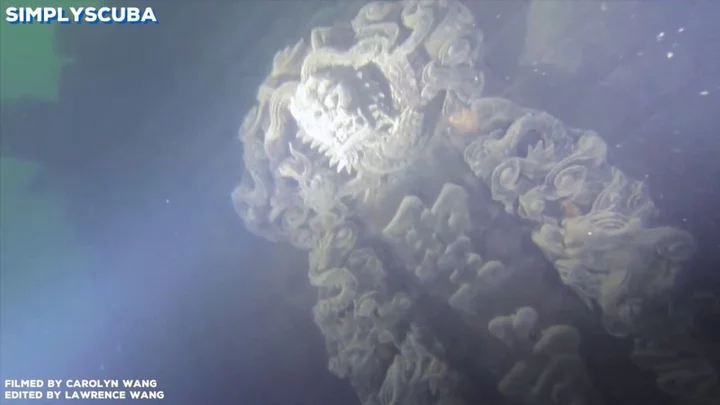
Ancient Chinese city found perfectly preserved at the bottom of a lake
Submerged beneath a manmade lake in China lies a forgotten city, dubbed by experts as “China’s Atlantis”. The underwater city, known as the Lion City or Shi Cheng, is hidden 40 metres beneath the surface of Qiandao Lake in eastern China. In 2001, officials discovered – or rediscovered – that the metropolis had been perfectly preserved after years underwater, and by 2017 had opened it up as a diving site for tourists. But what is the history of the Lion City, and how did it end up underwater? Shi Cheng is thought to have been built during the Eastern Han Dynasty between 25AD and 200AD. It was once a political and economic hub in the eastern province of Zhejiang, with a regional seat of power located in the city. The city walls, believed to date back to the 16th century, had five entrance gates, as opposed to the traditional four in old Chinese cities, and its wide streets contain 265 archways featuring stonework of dragons, phoenixes and (you guessed it) lions. However, in 1959, the Chinese government decided to build a hydroelectric power plant in the area and, somewhat shockingly, decided to flood the city to do it. This didn’t just amount to getting rid of a historical artefact. More than 300,000 people needed to be rehoused for the project, which ultimately birthed Qiandao Lake. A surprising side effect to this was that the city remains as a time capsule to the period when it was flooded. Since the water used to submerge it did not contain anything corrosive, and was not conducive to marine life, the remains are in perfect condition. And even though it was still functioning as a city until the mid-20th century, the Lion City has still not been completely mapped out. Now, divers are slowly working through each building, structure, archway, road and house to eventually put together a full picture of what it would have looked like. Until then, it will remain at least party shrouded in mystery, as China’s very own Atlantis. How to join the indy100's free WhatsApp channel Sign up to our free indy100 weekly newsletter Have your say in our news democracy. Click the upvote icon at the top of the page to help raise this article through the indy100 rankings.
2023-11-24 23:51
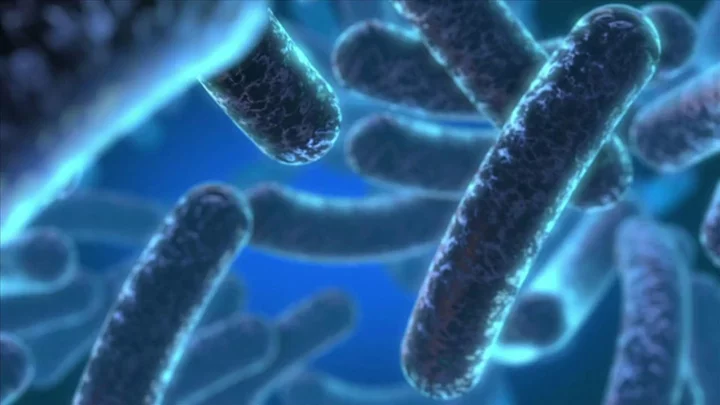
Scientists discover that bacteria has 'memories' that pass on to future generations
Scientists have made an astonishing discovery that suggests bacteria contain memories to be passed on to future generations. Researchers at the University of Texas and the University of Delaware found that despite having no brain or nervous system, certain bacteria may be able to form memories and remember certain behaviours depending on the available cellular iron. When iron levels are low, bacteria can hunt for local iron in their environment, prompting scientists to believe its memory has evolved, according to Science Alert. "Bacteria don’t have brains, but they can gather information from their environment, and if they have encountered that environment frequently, they can store that information and quickly access it later for their benefit," Souvik Bhattacharyya, the lead author of the recent study said. "We show [...] that a prior experience of swarming is remembered when Escherichia coli encounters a new surface, improving its future swarming efficiency," Souvik explained. "An iron-based memory might offer the advantage of providing a hub connecting various stress responses such as antibiotic survival and biofilms." The 'memories' lasted for around four generations, before generally coming to an end by the seventh. "Before there was oxygen in the Earth’s atmosphere, early cellular life was utilizing iron for a lot of cellular processes. Iron is not only critical in the origin of life on Earth, but also in the evolution of life,” the study author went on to explain. "It makes sense that cells would utilize it in this way." How to join the indy100's free WhatsApp channel Sign up for our free Indy100 weekly newsletter Have your say in our news democracy. Click the upvote icon at the top of the page to help raise this article through the indy100 rankings.
2023-11-24 22:21

Science has determined what the optimum length of time we should spend in a bath
There's nothing better than a hot bath to warm up and unwind on a chilly winter evening - but water bills don’t come cheap, so it’s more important than ever to make sure you’re making the most of your time in the tub. So how long should we be spending in the bath? Well, a recent study has uncovered that 22 minutes is the optimum length of time to spend in the bath. The study conducted by Victorian Plumbing sought to discover ULTIMATE bath time for relaxation, hydration and a good night’s sleep. There were 20 participants involved in the experiment - half male and half female - who took baths of varying lengths and rated how they felt afterward based on a number of factors. The study concluded that 22 minutes is the optimum amount of time to spend in the tub - to feel relaxed, hydrated, and sleep well after. Soaking should stop at 27 minutes if you don’t want to stay feeling hydrated post-bath, according to the study. This supports the advice of some professionals, who suggest that baths should be no longer than 30 minutes. It was also uncovered that baths impact men and women slightly differently. Women have a better night’s sleep after a longer bath, ideally, 30 minutes long, whereas men sleep better after 19 minutes. Those who felt more relaxed after the baths had scrolled on their phone during their time in the tub, whereas those who watched TV were found to be the least. Sorry to burst your bubble bath lovers, but the findings also suggest that people who take more baths are generally more stressed - although they find them more relaxing than shower- on the whole. “When the nights start getting colder in the UK, we tend to see an increase in Brits looking to buy a bath. And who can blame them? There are a number of benefits of a bath; they’re soothing, and cleansing and studies have even suggested that there are similar benefits to exercise," Brenna Ryan from Victorian Plumbing said about the study's findings. “To help you get the most out of your bath, we conducted a study which found that the optimum time to spend in the tub is 22 minutes - to leave you feeling relaxed, hydrated and sleep like a baby.” How to join the indy100's free WhatsApp channel Sign up to our free Indy100 weekly newsletter Have your say in our news democracy. Click the upvote icon at the top of the page to help raise this article through the indy100 rankings.
2023-11-24 19:59

Bill Gates says that technology can help make a 3 day work week possible
The five day week could soon be completely obsolete, if Bill Gates is to be believed. The Microsoft founder thinks that one of the results of AI will be the possibility of three day weeks becoming attainable for many people. While there are plenty of fears about the impact AI will have on the world economy and the potential dangers it poses to society, Gates believes it could mean humans ultimately have to do a lot less work to get by. Gates spoke on Trevor Noah’s What Now? podcast and the conversation turned to the possibilities that come hand in hand with AI. "If you eventually get a society where you only have to work three days a week, that's probably OK," he said. The billionaire also said that we could get to the stage where people can work fewer days to earn a living wage, as they co-exist in a world where "machines can make all the food and the stuff”. It’s not all positive, though. Gates previously warned about the dangers of AI in a blog over the summer. He wrote: "I don't think AI's impact will be as dramatic as the Industrial Revolution, but it certainly will be as big as the introduction of the PC. Word processing applications didn't do away with office work, but they changed it forever. Employers and employees had to adapt, and they did." Sign up for our free Indy100 weekly newsletter How to join the indy100's free WhatsApp channel Have your say in our news democracy. Click the upvote icon at the top of the page to help raise this article through the indy100 rankings
2023-11-24 00:54

Scientists have located a legendary Egyptian city that never appeared on maps
Experts have located a legendary lost city in Egypt that never appears on maps with the help of a mummy. Ancient Egyptians had an affinity for baboons thanks to their association with the God, Babi. Experts know that they were kept as pets in captivity and had their sharpest teeth removed to make them less harmful. And it is the Egyptians’ keeping of baboons that has led experts to the location of the mysterious Egyptian city of Punt thanks to their DNA. Gisela Kopp, a geneticist at the University of Konstanz, Germany who is studying baboon DNA explained to Live Science: “There were these stories that they got them from Punt, this fabled, mysterious land.” Punt has been mentioned in documentation from ancient Egypt, but experts have never been able to determine where it would actually lie on a map. But, in recent years, experts have been able to narrow down its exact location by looking at DNA from mummified baboons which have been discovered from the time period. Kopp and a group of colleagues were able to extract usable DNA from the remains of a mummified baboon believed to be from between 800 B.C. and 540 B.C. In their study, published in the journal eLife, they then compared that DNA to the genetic information of 14 baboons from known origins to compare specific information of geographic location. It revealed the baboon’s DNA was most closely related to populations from what are coastal areas of Eritrea today. Kopp explained, “It's close to this ancient port of Adulis”. Adulis is also mentioned in records dating from 300 B.C. onwards and is known as being a place that traders travelled to for wild animals. Kopp explained that there is now a working theory that Adulis and Punt may have been essentially the same place. “Maybe the earlier Punt was in a similar location to where Adulis was [later] established,” Kopp said. The study is based on the DNA of one mummified baboon, as the attempted extraction of fragile ancient DNA from nine other baboon mummies failed to yield usable samples. Experts hope to replicate their study with more DNA samples to gain more information from different time periods. How to join the indy100's free WhatsApp channel Sign up to our free indy100 weekly newsletter Have your say in our news democracy. Click the upvote icon at the top of the page to help raise this article through the indy100 rankings.
2023-11-24 00:46

Taylor Swift Concert Tragedy Highlights Dangers of Climate Change
The death of a Taylor Swift fan in the midst of a heat wave in Brazil is another
2023-11-24 00:26
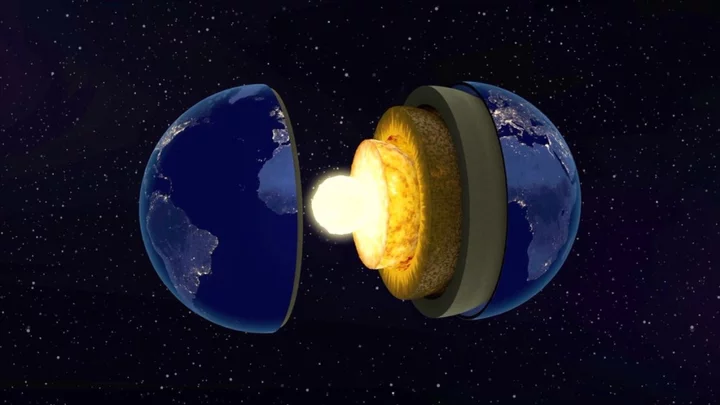
The Earth’s axis is shifting because of water
We’re discovering new things about the Earth all the time – just like scientists recently found water is slowly leaking down there from the surface, and people only just realising that there’s a massive ocean hidden under the Earth’s crust. Now, experts have found that the Earth’s axis appears to be shifting for a reason no-one saw coming. Essentially, the Earth’s tilt is changing over time. A few years ago, scientists put this down to global warming and the melting of the polar ice caps. However, experts have published new research which suggests that groundwater extraction is also playing a bigger factor than previously thought. The Earth’s poles can move with the melting of ice sheets. However, the depletion of groundwater caused by irrigation can also force the same thing to happen. While things are moving at a slow rate, with the North Pole moving gradually in the direction of the UK, the phenomenon does have the capacity to change the Earth’s seasons over time in theory. The most concerning thing, though, is what the new study published in Geophysical Research Letters suggests about the way we’re consuming Earth’s natural resources – especially when it comes to salty water being used on dehydrated land. Ki-Weon Seo of National University is co-lead on the study. She said in a statement: "Earth's rotational pole actually changes a lot. Our study shows that among climate-related causes, the redistribution of groundwater actually has the largest impact on the drift of the rotational pole." It comes after scientists recently discovered water is slowly leaking down there from the surface. The liquid is dripping down descending tectonic plates, before eventually reaching the core after a 2,900 kilometre journey. And while the process is slow, it has over billions of years formed a new surface between the molten metal of the outer core and the outer mantle of the Earth. Sign up for our free Indy100 weekly newsletter How to join the indy100's free WhatsApp channel Have your say in our news democracy. Click the upvote icon at the top of the page to help raise this article through the indy100 rankings
2023-11-22 23:49

Great white sharks keep entering the twilight zone and experts are mystified
Great white sharks are displaying unprecedented behaviours, and experts can’t explain why. One of the ocean’s greatest apex predators has been entering the twilight zone way beneath the surface of the ocean, and far beneath the areas they normally feed in. The twilight zone, also referred to as the mesopelagic zone, is the area 200 to 1,000 metres down below the surface which is at least partly permeated by sunlight. The midnight zone, meanwhile, is found 1,000 to 3,000 metres down and is impenetrable to sunlight. Now, a new study published in the journal PNAS offered insight into the behaviours of 344 tagged predatory fish including great white sharks. Scientists would usually expect the creatures studied to dive to the deep scattering layer (DSL), which is full of small fish and other ocean life forms and therefore attracts more predators than other levels. However, there was also evidence that suggested predators dove down far deeper than the DSL, and scientists don’t know why. According to the research, great white sharks dive down to as deep as 1,128 metres. Camrin Braun is assistant scientist at the Woods Hole Oceanographic Institution and study lead. Braun told Live Science: "How, when, where they access the deep ocean certainly varies, but the clear anecdotal answer is that the deep ocean seems like an important habitat regardless of the predator species. It's clear there are good reasons for these animals to dive deep, otherwise why would they all do it? "There's good evidence for some species/situations in which diving deep is clearly for foraging," Braun added. "So that supported our expectation. However, we also find several cases where we can pretty definitively say the use of the deep ocean is not for feeding – or if it is it represents a totally different kind of predator-prey interaction or mysterious prey resource." The study could suggest that the twilight zone could be far more important to great white sharks and other predatory fish than previously thought. "If it turns out that there is indeed more biomass in the twilight zone than in all current marine capture fisheries combined then it's possible to imagine a kind of mesopelagic 'gold rush' to catch and use this biomass," Braun said. "There are many 'ifs' in this chain and many issues in making mesopelagic fishing feasible but it seems that biomass may be important for predators. Therefore, we really need to better quantify those links between predators and mesopelagic biomass before we can sustainably harvest/use those resources.” Sign up for our free Indy100 weekly newsletter How to join the indy100's free WhatsApp channel Have your say in our news democracy. Click the upvote icon at the top of the page to help raise this article through the indy100 rankings
2023-11-22 23:26

What is biohacking – the latest wellness trend taking over TikTok?
Biohacking is the latest wellness trend taking the internet by storm, with TikTok witnessing a staggering 316 per cent increase in searches. More notably, Bryan Johnson, the founder of KernelCo and Blueprint, has contributed to the intrigue after investing approximately $2 million per year to reduce his biological age. The 46-year-old tech tycoon recently made headlines for tracking his nighttime erections, in an attempt to reach the level of an 18-year-old. How exactly does he do that, you may ask? Well... He gives himself electric shocks in his private area. Johnson told Steven Bartlett on The Diary of a CEO podcast that nighttime erections "are actually a meaningful health indicator" because they "represent psychological health, cardiological health." While that's one extreme measure of biohacking, there are other methods behind the trend. A spokesperson for Snusboss said: "Biohacking refers to the practice of making changes to one’s biology, typically through self-experimentation and the use of technology, to enhance physical and cognitive abilities, optimize health, and achieve personal goals." “Currently #biohacking has 791 million views on TikTok, and continues to gain popularity, particularly with Millennials and Generation Z who are becoming more interested in the scientific research behind their health and wellbeing and are also open to experimenting with new techniques," he continued. Biohacking is essentially an unconventional experimental biotechnology that is believed to help improve overwell wellbeing. Here are several ways people are implementing into their lives: Ice cold plunge "Cold plunging is an aspect of cold-water therapy or cold-water immersion, which involves immersing oneself in cold water temperatures. "It is recommended to complete 11 minutes of cold-water exposure per week, which can be broken into three minutes per session. "Studies suggest 50 to 59 degrees Fahrenheit (10 to 15 degrees Celsius) to be an optimal temperature range for cold plunges focused on reducing muscle soreness. "Doing this will also help to reduce inflammation, improve circulation, and enhance recovery after exercise. It is also shown to boost the immune system, improve sleep quality and help with stress management." Optimise your sleep "If you are getting around seven to nine hours of sleep a night, you will encourage muscle growth and repair, help keep your brain alert, improve your blood sugar levels and even enhance your lifespan. "Whilst there are several tips on social media such as eating certain fruits before bed, avoiding electronic devices and avoiding alcohol, one of the most important rules of optimizing sleep is maintaining a good circadian rhythm. "This means going to bed and waking up at the same time every day, even on weekends. To do so, try maintaining a routine and try to spend time outdoors during daylight, especially in the morning. This is because natural light exposure helps regulate your body's internal clock and promotes alertness during the day. "To measure progress, you can use devices such as smartwatches that track sleep duration and quality." Regular saunas "Saunas, small rooms heated with hot air or steam, are said to have cardiovascular health benefits. "When exposed to high temperatures, the body then works to cool itself down by increasing heart rate, blood flow, and cardiac output. This is known to decrease blood pressure, leading to benefits for cardiovascular health and longevity. "For best results from this biohack, choose a temperature between 175-195F (80-90C) with 10-20 per cent humidity for 30 minutes at least three times a week." Himalayan salt in water "Electrolyte levels are important for the body to function properly. They help to balance the amount of water in your body, balance your acid/base (pH) levels and move nutrients into your cells. "Your body makes electrolytes naturally, as well as obtaining them from food, drinks and supplements. "However, if your levels drop, mineral-rich Himalayan salt contains lots of electrolytes and is proven to help detox the body, supporting kidney and liver functions. "Therefore, around one teaspoon of Himalayan salt added to one litre of water is recommended per day. "Not only will it keep you feeling energised, but also help to boost your metabolism." Moderate coffee intake "Low to moderate doses of caffeine (50–300 mg) are scientifically proven to cause increased alertness, energy, and ability to concentrate. "Science also suggests drinking two cups of coffee a day could help ward off heart failure when a weakened heart has difficulty pumping enough blood to the body. "Both regular and decaf coffee have a protective effect on the liver. Research shows that coffee drinkers are more likely to have liver enzyme levels within a healthy range than people who don’t drink coffee. "Experts say it is healthy to drink a maximum of 2.5 cups of coffee per day." Breathwork "We breathe every single day, but we often don’t even think about how we are breathing. "In times of stress, our breath automatically responds by shortening and speeding up and this can cause further strain on the body. "With breathwork practice, the body can be trained to automatically control breathing and utilize it as a calming tool during times of stress. "Breathing also directly affects how much oxygen our cells are getting, so when we deepen and slow down the breath from its usual pattern, we allow more oxygen to enter each cell. "To practice breathwork, inhale for 4 seconds and exhale for 6 seconds. Repeat this for around 10 minutes per session. For best results, do this once in the morning and once in the evening." Red Light Therapy (RLT) "Red light therapy (RLT) is a popular method used to optimize overall skin health. RLT also helps to boost muscle recovery, reduce pain and inflammation, support nervous system health, and generally increase energy levels. "For those who experience inflammation and pain with Achilles tendinitis, and have signs of skin ageing and skin damage, research shows RLT may smooth your skin and help with wrinkles. RLT is also known to help with acne scars, burns, and signs of UV sun damage. "To complete the treatment, lie in a full-body LED red light bed or pod or be treated by a professional with a device that's outfitted with panels of red lights. "Professionals recommend trying red light therapy three times per week for 10 minutes each time for a minimum of one month." How to join the indy100's free WhatsApp channel Sign up for our free Indy100 weekly newsletter Have your say in our news democracy. Click the upvote icon at the top of the page to help raise this article through the indy100 rankings.
2023-11-22 20:19
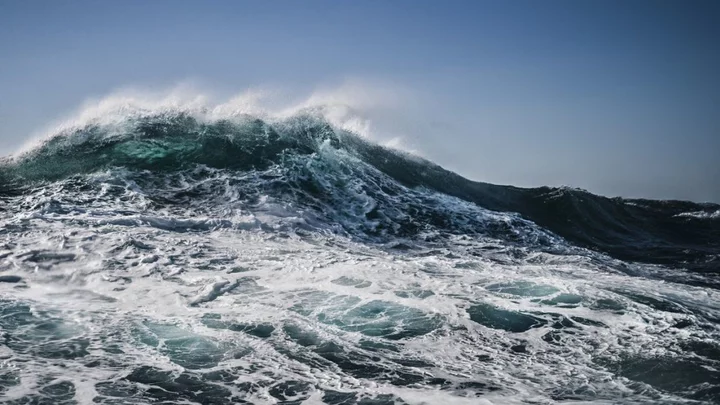
Scientists discover giant missing blob of water in the middle of the Atlantic
To the uninitiated, there isn’t much to water. Sure, the world’s oceans are filled with monsters, marvels and mysteries but, otherwise, they’re just vast, singular expanses of liquid. Right? Wrong. Far from being uniform everywhere, ocean water is a patchwork of interlinked layers and masses which mix and split apart thanks to currents, eddies, and changes in temperature or salinity. Indeed, beneath the surfaces of our great seas, there are waterfalls, rivers and even gigantic blobs, stretching thousands of miles, that somehow manage to evade detection. Now, scientists have discovered one of these massive blobs in the middle of the Atlantic Ocean; extending from the tip of Brazil to the Gulf of Guinea. Until the discovery of this water mass – which has been named the Atlantic Equatorial Water – experts had seen waters mixing along the equator in the Pacific and Indian oceans, but never in the Atlantic. "It seemed controversial that the equatorial water mass is present in the Pacific and Indian oceans but missing in the Atlantic Ocean because the equatorial circulation and mixing in all three oceans have common features," Viktor Zhurbas, a physicist and oceanologist at The Shirshov Institute of Oceanology in Moscow, told Live Science. "The identified new water mass has allowed us to complete (or at least more accurately describe) the phenomenological pattern of basic water masses of the World Ocean." As the name suggests, the Atlantic Equatorial Water is formed by the mixing of separate bodies of water by currents along the equator. To distinguish such masses from the water surrounding them, oceanographers analyse the relationship between temperature and salinity across the ocean — which determines the density of the seawater. Back in 1942, this charting of temperature-salinity led to the discovery of equatorial waters in the Pacific and Indian oceans, as Live Science notes. Because they are created by the mixing of waters to the north and south, the Indian and Pacific Equatorial waters share similar temperatures and salinities curving along lines of constant density, which make them easy to distinguish from the surrounding water. And yet, for years, no such relationship could be spotted in the Atlantic. However, thanks to data collected by the Argo programme – an international collection of robotic, self-submerging floats which have been installed across Earth’s oceans – the researchers spotted an unnoticed temperature-salinity curve located parallel to the North Atlantic and South Atlantic Central waters. This was that elusive Atlantic Equatorial Water. "It was easy to confuse the Atlantic Equatorial Water with the South Atlantic Central Water, and in order to distinguish them it was necessary to have a fairly dense network of vertical temperature and salinity profiles covering the entire Atlantic Ocean," Zhurbas explained in his email to Live Science. The discovery is significant because it offers experts a better understanding of how oceans mix, which is vital to how they transport heat, oxygen and nutrients around the world. Sign up for our free Indy100 weekly newsletter Have your say in our news democracy. Click the upvote icon at the top of the page to help raise this article through the indy100 rankings
2023-11-22 17:55

Earth has just received a message from 10 million miles away
An experiment to see if a laser could beam a message through space to Earth has been successful and could alter the future of spacecraft communication. The experiment was made possible by the Deep Space Optical Communications (DSOC) tool which was travelling onboard NASA’s Psyche spacecraft. It was successfully able to beam a message to Earth, via a near-infrared laser, from far beyond the Moon. It is the furthest such optical communication to have ever been communicated and was encoded with test data to ensure that it worked correctly. The DSOC successfully beamed the data from approximately 16 million kilometers (10 million miles) away to the Hale Telescope at Caltech’s Palomar Observatory in California. Hitching a ride on the Psyche spacecraft, the experiment achieved the so-called “first light” on 14 November, according to NASA's Jet Propulsion Laboratory which is managing the mission from Earth. NASA explained the demo’s “flight laser transceiver – a cutting-edge instrument aboard Psyche capable of sending and receiving near-infrared signals – locked onto a powerful uplink laser beacon transmitted from the Optical Communications Telescope Laboratory at JPL’s Table Mountain Facility near Wrightwood, California.” The uplink beacon assisted the transceiver in aiming its downlink to Caltech’s observatory, where the signal was received. Trudy Kortes, director of Technology Demonstrations at NASA HQ, said: “Achieving first light is one of many critical DSOC milestones in the coming months, paving the way toward higher-data-rate communications capable of sending scientific information, high-definition imagery, and streaming video in support of humanity’s next giant leap: sending humans to Mars.” It’s not the first time that optical communications have been used to beam messages from space, but these laser beams mark the furthest a message has ever been transmitted. With missions further than the moon, NASA typically uses radio waves to communicate. However, laser beams allow for a greater amount of data to be packed in them, potentially giving experts more options in future missions. Dr Jason Mitchell, director of the Advanced Communications and Navigation Technologies Division within NASA’s Space Communications and Navigation program, explained: “Optical communication is a boon for scientists and researchers who always want more from their space missions, and will enable human exploration of deep space.” How to join the indy100's free WhatsApp channel Sign up to our free indy100 weekly newsletter Have your say in our news democracy. Click the upvote icon at the top of the page to help raise this article through the indy100 rankings.
2023-11-21 23:26
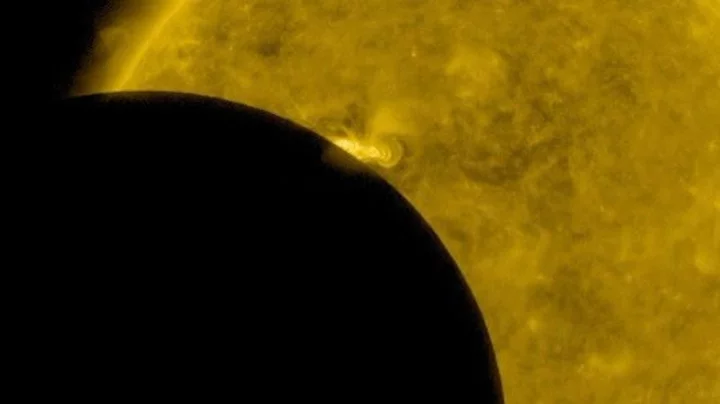
Chinese rocket that hurtled into the Moon was carrying a ‘secret object’
A mysterious object crashed into the Moon last year, and scientists think they’ve finally figured out what it was. On March 4, 2022, a piece of space junk hurtled towards the surface of our celestial companion, leaving behind not one but two craters – prompting speculation as to what exactly the manmade object was. And now, in a paper published in the Planetary Science Journal, a team of researchers at the University of Arizona (UArizona) have offered “definitive proof” that it was a booster from a Chinese space rocket that had spent several years hurtling through space. But the most interesting part of all this? The defunct piece of spacecraft was apparently carrying a secret cargo. Initially, based on its path through the sky, the UArizona team thought it was an errant SpaceX Falcon 9 rocket booster from a 2015 launch. However, after analysing how precise light signals bounced off its surface, they later concluded that it was more likely to be a booster from a Chang'e 5-T1 – a rocket launched back in 2014 as part of China’s lunar exploration programme. And yet, the Chinese space agency denied ownership, insisting that their rocket booster burned up in the Earth's atmosphere upon re-entry. But the US Space Command refuted this claim by revealing that the rocket’s third stage never re-entered the planet’s atmosphere. Furthermore, two key pieces of evidence gathered by the UArizona researchers suggested that there was more to the object than just a simple abandoned rocket booster. Firstly, the way it reflected light. The paper’s lead author, Tanner Campbell, explained in a statement: "Something that's been in space as long as this is subjected to forces from the Earth's and the moon's gravity and the light from the sun, so you would expect it to wobble a little bit, particularly when you consider that the rocket body is a big empty shell with a heavy engine on one side. “But this was just tumbling end-over-end, in a very stable way." In other words, the rocket booster must have had some kind of counterweight to its two engines, each of which would have weighed around 545kg (1,200lbs) without fuel. The stability with which the object rotated led Campbell and his colleagues to deduce that “there must have been something more mounted to [its] front”. Secondly, the team were struck by the impact the booster left when it slammed into the Moon. It created two craters, around 100ft (30.5 metres) apart, instead of one, which, according to Campbell was very unusual. He pointed out that the craters left behind by Apollo rockets are either round, if the object came straight down, or oblong if it crashed down at a shallow angle. "This is the first time we see a double crater," he said. "We know that in the case of Chang'e 5 T1, its impact was almost straight down, and to get those two craters of about the same size, you need two roughly equal masses that are apart from each other." And yet, despite the rigour of their investigation, the UArizona team have been unable to identify what exactly this additional object was. "We have no idea what it might have been – perhaps some extra support structure, or additional instrumentation, or something else," Campbell admitted. "We probably won't ever know." Sign up for our free Indy100 weekly newsletter Have your say in our news democracy. Click the upvote icon at the top of the page to help raise this article through the indy100 rankings
2023-11-21 20:25
